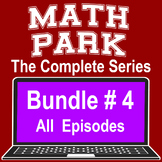IDENTIFYING AND COMPARING FRACTIONS - MATH PARK - VIDEO/EASEL LESSON #302
- Streaming Video(cannot be downloaded)
- Supporting Information
- Easel Activity
- Easel Assessment
Also included in
- Would you like to find new ways of giving your students a good foundation with fraction and decimal concepts? Give the Emmy Award-winning MATH PARK a try! These NO-PREP VIDEO LESSONS and follow-up EASEL ACTIVITIES and ASSESSMENTS can give your students the differentiated help they need. Here’s what’Price $15.00Original Price $20.00Save $5.00
- Would you like to find new ways of giving your students a good foundation with number sense, multiplication, and fraction & decimal concepts? Give the Emmy Award-winning MATH PARK a try! These NO-PREP VIDEO LESSONS and follow-up EASEL ACTIVITIES and ASSESSMENTS can give your students the differePrice $45.00Original Price $57.50Save $12.50
Description
Would you like to find new ways of giving your students a good foundation with fraction concepts? Give the Emmy Award-winning MATH PARK a try! This NO-PREP VIDEO LESSON and follow-up EASEL ACTIVITIES can give your students the differentiated help they need.
The concepts and skills taught in MATH PARK 302 include:
- Learning the meaning and relationship of the numerator and denominator in fractions
- Identifying fractions after viewing different visual representations, such as bars, squares, rectangles, and circles
- Comparing fractions when the numerators are the same but the denominators are different, such as one-third is larger than one-fourth
”
Here’s what’s included:
- A fifteen-minute teaching VIDEO LESSON
- A printable TEACHER GUIDE for making the video lesson more effective
- Four interactive EASEL ACTIVITIES to reinforce the concepts/skills
- An automatically graded EASEL ASSESSMENT for teacher feedback
Here’s what satisfied teachers and parents are saying:
“Math Park is extraordinary! My students love it and actively participate in this interactive math resource. It’s always a treat for them when an episode is shown. Even my most reluctant math learners are engaged. Math Park has a wonderful way of making even the most daunting math concepts accessible to all – in an enjoyable and painless way.”
Natali Escobedo, Teacher
Los Angeles, California
The lesson is awesome and certainly one I will be using and recommending it to other teacher friends to use in the classroom. This is a hard lesson for kids to understand and the video is so creative and fun! I can’t wait to teach fractions and celebrate math by making a rainbow cake in the classroom!”
Sonya Snyder, Teacher
Tuscaloosa, Alabama
I hope you will give MATH PARK a try in your classroom or at home!
I would appreciate your REVIEW/RATING of this MATH PARK lesson.
Please follow me at: https://www.teacherspayteachers.com/Store/Lucky-Cat-Productions
Thanks!
Robert



